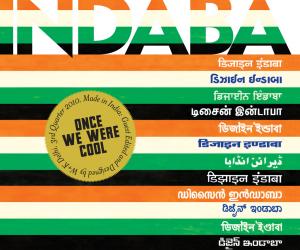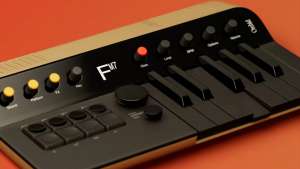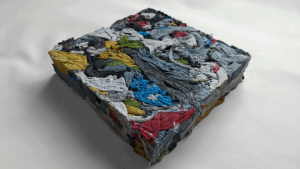First Published in

In the beginning, before light, there was sound. In the primordial dawn stretching back to the Vedas, the ancient and austere musical tradition of dhrupad was born. Using initially only three notes, dhrupad was meant to be a divine, ecstatic experience, an endless attempt by the singer to achieve the mystical “Om” sound and thus enter into a higher state of consciousness. Dhrupad was primarily performed in temples, with the singer directly facing the deity and the audience was merely incidental. The aim of the singing was to produce a contemplative experience for the listeners. After flourishing for centuries, and finding a place in the great Mughal courts, the popularity of dhrupad began to die out in the early 18th century. Musical tastes began to favour the lyrical and entertaining Hindustani forms of dhamar and khayal, until dhrupad had all but died out by the 19th century.
Amit Chaudhuri writes about dhrupad, the mother of Indian classical music.
Things change – buildings become ruins, cities vanish, and languages and art forms and genres disappear. Very occasionally, texts are rediscovered; practices resurrected. What can one say about the dhrupad? Clearly it flourished until the 17th century, and then began gradually to fade with the advent of the new and compelling hybrid, the khayal, in the 18th century. It was then that Niyamat Khan (using the pseudonym “Sadarang” or “perpetually creative”) and his nephew Firoz Khan (“Adarang”) began to compose the structured pieces – bandish (literally stricture or composition) – by which we recognise the form today.
According to recognised custom, the shadowy composer names himself in these pieces (which are frequently sung today, Sadarang and Adarang becoming momentarily reincarnated in the persona of the contemporary khayal singer), but also named within that song is the sovereign in whose court these great works were first performed, and under whose patronage they came into being: Muhammad Shah Rangila. Notice the word rang, and how it’s everywhere in the last two sentences: it means colour, as we know, but it also denotes vivaciousness, inward youthfulness, creativity, and joie de vivre; some people even claim that it has the same root as raga (which is a musical mode or theme explored according to the rules of particular classical genres), and that maybe the second word derives from the first.
Clearly, Muhammad Shah was a man given to raga and rang and pleasure: he was also an emperor in the final days of the Mughal Empire, accused, in retrospect, of being a negligent administrator, the sort of Oriental king to whom the adjectives “decadent” and “irresponsible” are often appended. In 1739, he lost Delhi to the irresistible scourge of the Persian invader, Nadir Shah. It’s in this context of historic upheaval and absolute transformation that the rise of the compelling successor to the dhrupad – the khayal – must be placed. In Sadarang and Adarang’s compositions, the emperor’s court, mentioned in passing – “Muhammad Shah ke Sadarangile” – is still the centre of the world; the composers have no inkling (how could they?) of how imminent its passing is; in the music, though, they remain forever alive and nubile – sada rangile.
War and contestation are not only the context of this music and, indeed, of much of art; they are, invariably, their substance and life-blood. One genre or form or treatment or parameter or way of singing or writing annihilates another as it takes, literally, centre-stage; certain approaches suddenly become impossible for an artist.
What was it about the khayal that took the initiative from the dhrupad? There was the greater freedom of the new form, for one; its spaciousness, which allowed the musician to adhere to the cycle of tala (the time-signature) while exploring the progression of the raga with an unthinkable tonal minuteness and leisureliness – to express, in the process, an intense romantic yearning that would have been considered inadmissible to the classically austere dhrupad.
The khayal belongs, then, to a lineage of Indian individualism and romanticism (as the meaning of the word khayal, “imagination,” implies), although the biographical outlines of its creators and performers are sketchy in comparison to their Western counterparts. The dhrupad is from an earlier world of classicism: of abnegation, strength, austerity, dignity – indeed, heroic dignity. Its concerns, in spite of its devotional nature – most dhrupad compositions are addressed in adoration to Radha and Krishna – are abstract and mathematical; carefully premeditated multiples of the time-signature (say, 12 times one and a half, 12 times two, 12 times three) concern the performer. These mathematical developments mimic the complex ripples set off by the presence of the sublime. You cannot wholly participate in the drama of the dhrupad without participating in the time-signature; as you can, and as we do, for instance with the khayal and its instrumental counterparts, taking pleasure in the weavings in and out of the raga and the texture of the singer’s voice.
The dhrupad denies instant access and pleasure in at least a couple of ways. It prohibits the spontaneous, improvisatory virtuosity we associate with Indian music, and which the khayal largely brought into being. And the pakhawaj (barrel shaped, two-headed drum), unlike the tabla (which Amir Khusro reportedly invented by dividing the pakhawaj into two), makes no concessions to sweetness, nor to the listener’s grasp on tala: as the singer embarks on the multiples of the time-signature, so does the pakhawaj, creating a flat-sounding but intricate crescendo (unlike the tabla, which simply keeps time as the singer improvises on the tala, making it easier for the listener to get a handle on the rhythm). The pakhawaj, with its mixture of directness, sparseness, and great intricacy, is a heroic instrument; whereas the tabla has an instantaneous and infectious magic that can disarm you even if you know nothing of the tala or time-signature.
The dhrupad has the mark, and is probably the originator, of the curiously hybrid spirituality that makes Indian classical music, including khayal, unique: notice how Muslim performers surrender, through this form, to the mood of bhakti, of devotion to the fickle Krishna. This is not some easy and attractive syncreticism: the singers of the dhrupad – say from the extensive Dagar family (which is Muslim) – are not proto-liberals, “people like us.” There’s something else at work, something more mysterious, that ebbs and flows between contestation and surrender.
I recall meeting Aminuddin Dagar (of the Dagar Brothers, who were at the heart of the dhrupad revival initiated by Alain Daniélou) in the late 1970s in a flat on Malabar Hill in Bombay; my mother and I had been invited home by a self-styled corporate aficionado of classical music. Not far away, the recent hit song, “Aap jaise koi mere zindagi me aaye” (“Somebody like you came into my life”) was playing. The world was changing again. My mother, as if she were commenting on some carving from history rather anything more immediate, stared at Aminuddin Dagar and said: “You look just like a Brahmin.” He smiled with great forbearance and replied: “My forefathers were Brahmins.” He spoke of how an insult from a potentate had led to the ancestor changing his religion in a fit of anger. (He was, in a way, relating an episode that replicated the supreme Indian singer Miyan Tansen’s history – Tansen, who, in the early 16th century, had converted to Islam though he was born a Brahmin.) Ustad Dagar’s story was not really surprising: Indian life – especially a musician’s life – is full of insults, slights, rebuffs and injustices. Nor is it surprising that the bhakti (devotion) in dhrupad singing should be very real.
There are notable continuities between the dhrupad and the khayal, of course: the lovely meends or glissandos that are dhrupad’s great contribution to our music; the majestic gamaks, or musically undulating notes; layakari, or mastery over time. All these give to Indian music its gravity and joy. Perhaps we need this gravity, this difficulty, once again: the improvisations of the khayal are now near bankrupt. But long-superannuated genres like the dhrupad don’t attract the most gifted artists – we should be honest about this. Once it had our greatest singers among its practitioners: such as Tansen and his teacher, Swami Haridas. It seems unlikely that moment will happen again.
Amit Chaudhuri is a writer and his latest novel is The Immortals. He is also a musician and composer.
Trance music, invented in India, 400 BC
In the beginning, before light, there was sound. In the primordial dawn stretching back to the Vedas, the ancient and austere musical tradition of dhrupad was born. Using initially only three notes, dhrupad was meant to be a divine, ecstatic experience, an endless attempt by the singer to achieve the mystical “Om” sound and thus enter into a higher state of consciousness. Dhrupad was primarily performed in temples, with the singer directly facing the deity and the audience was merely incidental. The aim of the singing was to produce a contemplative experience for the listeners. After flourishing for centuries, and finding a place in the great Mughal courts, the popularity of dhrupad began to die out in the early 18th century. Musical tastes began to favour the lyrical and entertaining Hindustani forms of dhamar and khayal, until dhrupad had all but died out by the 19th century.
Amit Chaudhuri writes about dhrupad, the mother of Indian classical music.
Things change – buildings become ruins, cities vanish, and languages and art forms and genres disappear. Very occasionally, texts are rediscovered; practices resurrected. What can one say about the dhrupad? Clearly it flourished until the 17th century, and then began gradually to fade with the advent of the new and compelling hybrid, the khayal, in the 18th century. It was then that Niyamat Khan (using the pseudonym “Sadarang” or “perpetually creative”) and his nephew Firoz Khan (“Adarang”) began to compose the structured pieces – bandish (literally stricture or composition) – by which we recognise the form today.
According to recognised custom, the shadowy composer names himself in these pieces (which are frequently sung today, Sadarang and Adarang becoming momentarily reincarnated in the persona of the contemporary khayal singer), but also named within that song is the sovereign in whose court these great works were first performed, and under whose patronage they came into being: Muhammad Shah Rangila. Notice the word rang, and how it’s everywhere in the last two sentences: it means colour, as we know, but it also denotes vivaciousness, inward youthfulness, creativity, and joie de vivre; some people even claim that it has the same root as raga (which is a musical mode or theme explored according to the rules of particular classical genres), and that maybe the second word derives from the first.
Clearly, Muhammad Shah was a man given to raga and rang and pleasure: he was also an emperor in the final days of the Mughal Empire, accused, in retrospect, of being a negligent administrator, the sort of Oriental king to whom the adjectives “decadent” and “irresponsible” are often appended. In 1739, he lost Delhi to the irresistible scourge of the Persian invader, Nadir Shah. It’s in this context of historic upheaval and absolute transformation that the rise of the compelling successor to the dhrupad – the khayal – must be placed. In Sadarang and Adarang’s compositions, the emperor’s court, mentioned in passing – “Muhammad Shah ke Sadarangile” – is still the centre of the world; the composers have no inkling (how could they?) of how imminent its passing is; in the music, though, they remain forever alive and nubile – sada rangile.
War and contestation are not only the context of this music and, indeed, of much of art; they are, invariably, their substance and life-blood. One genre or form or treatment or parameter or way of singing or writing annihilates another as it takes, literally, centre-stage; certain approaches suddenly become impossible for an artist.
What was it about the khayal that took the initiative from the dhrupad? There was the greater freedom of the new form, for one; its spaciousness, which allowed the musician to adhere to the cycle of tala (the time-signature) while exploring the progression of the raga with an unthinkable tonal minuteness and leisureliness – to express, in the process, an intense romantic yearning that would have been considered inadmissible to the classically austere dhrupad.
The khayal belongs, then, to a lineage of Indian individualism and romanticism (as the meaning of the word khayal, “imagination,” implies), although the biographical outlines of its creators and performers are sketchy in comparison to their Western counterparts. The dhrupad is from an earlier world of classicism: of abnegation, strength, austerity, dignity – indeed, heroic dignity. Its concerns, in spite of its devotional nature – most dhrupad compositions are addressed in adoration to Radha and Krishna – are abstract and mathematical; carefully premeditated multiples of the time-signature (say, 12 times one and a half, 12 times two, 12 times three) concern the performer. These mathematical developments mimic the complex ripples set off by the presence of the sublime. You cannot wholly participate in the drama of the dhrupad without participating in the time-signature; as you can, and as we do, for instance with the khayal and its instrumental counterparts, taking pleasure in the weavings in and out of the raga and the texture of the singer’s voice.
The dhrupad denies instant access and pleasure in at least a couple of ways. It prohibits the spontaneous, improvisatory virtuosity we associate with Indian music, and which the khayal largely brought into being. And the pakhawaj (barrel shaped, two-headed drum), unlike the tabla (which Amir Khusro reportedly invented by dividing the pakhawaj into two), makes no concessions to sweetness, nor to the listener’s grasp on tala: as the singer embarks on the multiples of the time-signature, so does the pakhawaj, creating a flat-sounding but intricate crescendo (unlike the tabla, which simply keeps time as the singer improvises on the tala, making it easier for the listener to get a handle on the rhythm). The pakhawaj, with its mixture of directness, sparseness, and great intricacy, is a heroic instrument; whereas the tabla has an instantaneous and infectious magic that can disarm you even if you know nothing of the tala or time-signature.
The dhrupad has the mark, and is probably the originator, of the curiously hybrid spirituality that makes Indian classical music, including khayal, unique: notice how Muslim performers surrender, through this form, to the mood of bhakti, of devotion to the fickle Krishna. This is not some easy and attractive syncreticism: the singers of the dhrupad – say from the extensive Dagar family (which is Muslim) – are not proto-liberals, “people like us.” There’s something else at work, something more mysterious, that ebbs and flows between contestation and surrender.
I recall meeting Aminuddin Dagar (of the Dagar Brothers, who were at the heart of the dhrupad revival initiated by Alain Daniélou) in the late 1970s in a flat on Malabar Hill in Bombay; my mother and I had been invited home by a self-styled corporate aficionado of classical music. Not far away, the recent hit song, “Aap jaise koi mere zindagi me aaye” (“Somebody like you came into my life”) was playing. The world was changing again. My mother, as if she were commenting on some carving from history rather anything more immediate, stared at Aminuddin Dagar and said: “You look just like a Brahmin.” He smiled with great forbearance and replied: “My forefathers were Brahmins.” He spoke of how an insult from a potentate had led to the ancestor changing his religion in a fit of anger. (He was, in a way, relating an episode that replicated the supreme Indian singer Miyan Tansen’s history – Tansen, who, in the early 16th century, had converted to Islam though he was born a Brahmin.) Ustad Dagar’s story was not really surprising: Indian life – especially a musician’s life – is full of insults, slights, rebuffs and injustices. Nor is it surprising that the bhakti (devotion) in dhrupad singing should be very real.
There are notable continuities between the dhrupad and the khayal, of course: the lovely meends or glissandos that are dhrupad’s great contribution to our music; the majestic gamaks, or musically undulating notes; layakari, or mastery over time. All these give to Indian music its gravity and joy. Perhaps we need this gravity, this difficulty, once again: the improvisations of the khayal are now near bankrupt. But long-superannuated genres like the dhrupad don’t attract the most gifted artists – we should be honest about this. Once it had our greatest singers among its practitioners: such as Tansen and his teacher, Swami Haridas. It seems unlikely that moment will happen again.
Amit Chaudhuri is a writer and his latest novel is The Immortals. He is also a musician and composer.







